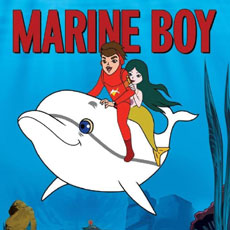Mushi Productions (1963), The Right Stuf International (March 28, 2006), 11discs per set, 1220 + 1272 mins plus supplements, 1.33:1 original full frame ratio, Dolby Digital Mono, Not Rated, Retail: $129.99 each
Storyboard:
Osamu Tezuka’s comic strip creation soars in his first animated series. A robot boy, created by a grieving father, becomes a hero to Japan even as he struggles to learn to live among humans.
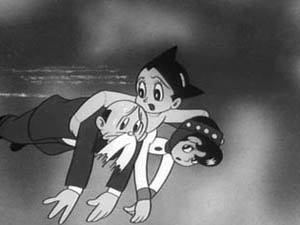
The Sweatbox Review:
Anime has been a big part of the animated DVD scene from the beginning, so to the uninformed it is perhaps a little surprising that it took so long to bring out the original Astro Boy onto the format. Astro Boy was, after all, among the very first Japanese animated cartoon shows, and the first one to hit it big in the United States, starting in 1963. It later had two revivals, one from the 1980s, and one that didn’t quite catch on in North America just a few years ago. These revivals both made it to DVD before the original, a small frustration for fans and cartoon history buffs like myself. Finally, Madman Entertainment managed to put together two huge box sets of the English-language version of the 1960s Astro Boy. It was released first in Australia, and now it is available in Region 1 from Right Stuf International. Putting an Astro Boy set together was difficult to do, as the original English version copies were destroyed in 1975 after being returned to Japan. By scouring the world and delving into the collections of private collectors, all of the English episodes have been found for inclusion on these DVD sets. And now, we can see if the wait was worth it. Although a number of episodes have been released previously on tape, this is the collector’s best opportunity to examine the series in the most possibly complete presentation.
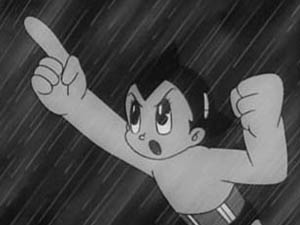
The character of Astro Boy began life as a comic book (manga) in Japan, written and drawn by master cartoonist Osamu Tezuka. Debuting in 1951, his actual name was Tetsuwan Atom, or “Mighty Atom”, and he was initially a supporting character in a Shonen boys’ magazine story called Atom Tashai (Ambassador Atom, or Captain Atom as it has sometimes been called). Tezuka was a medical student at the time, but eventually his career as a cartoonist took precedence and he abandoned his medical career (after receiving his degree) and produced Mighty Atom comic strip stories for eighteen years.
The story of Mighty Atom has become a modern myth in Japan. Dr. Tenma, the director of the Ministry Of Science, suffers the loss of his son Tobio in a traffic accident. The brilliant man goes mad, and dedicates the Ministry’s resources to building him a new son. The robot is “born” on April 7, 2003. Tenma, not being quite right in the head, comes to see the new robot as human; but after some time he comes to realize that the robot is not growing. His madness lifts just enough for him to see the bitter truth, and he becomes angry and sells the construct to a robot circus. Professor Ochanomizu, who has taken over at the Ministry from the departed Tenma, spots the robot there. The professor brings the robot back to the Ministry and becomes his guardian. From then on, Mighty Atom becomes a hero for peace in Japan, aided by his tremendous “100,000 horsepower strength”, rocket-powered flight, and other abilities. Eventually, his supporting cast grows to include a robotic family, classmates from a local elementary school, their teacher Mr. Mustachio, and assorted friends and foes. Mighty Atom’s futuristic world is inhabited by many other robots, and the stories often acknowledge their difficulty in co-existing with humans in a dignified way.
With Mighty Atom such a lasting success, it was a natural property to bring to television. Tezuka himself was highly involved in the creation of the TV show, one of the very first Japanese cartoon shows (often it is said to be the very first, but apparently there were others). It was a production of Tezuka’s own Mushi Productions. It aired Sundays at 5:30, and became a huge success in Japan over its 193 episodes. It found acceptance in America as well, when producer Fred Ladd adapted the show for an American audience. New scripts and English dubbing were used for the existing animation of many but not all of the Japanese shows, eventually resulting in 104 English language episodes of the newly christened Astro Boy. The first season of 52 episodes debuted in the U.S. in September 1963, just eight months after first being shown in Japan. Oddly, the show was syndicated, and never did appear on the NBC network despite being handled by NBC Enterprises. Despite this, NBC was thrilled so much with the show that they advanced monies to Tezuka for the second batch of 52 episodes, thereby allowing him to use better animation for the following season. (NBC largely did so because Mushi was doing them for Japanese television anyways, and NBC did not want the new batch of shows to be sold to an American competitor.) That second season, however, would be the last one that NBC would be involved with. They were more than satisfied with 104 episodes, and did not care for the increasingly violent and yet cerebral stories. Mighty Atom would continue in Japan, but Astro Boy would only get reruns in the U.S.
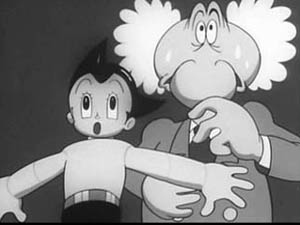
In the process of bringing those 104 episodes to American viewers, many things were changed, most obviously the names of the characters. Many of the names were a cross between clever and silly. The young child of Dr. Tenma became Astor, son of Dr. Boynton. The large-nosed guardian of Mighty Atom became Astro Boy’s guardian Dr. Packadermus J. Elefun, head of the Institute Of Science. Characters who showed up later would have such names as Don Tay, master on the Infernal Machine (i.e. Dante’s Inferno— groan), Clyde Snidely, Dr. I.M. Sinister, Mr. Pompous, and Professor I.Q. Plenty.
Another change for American kids was the level of violence to be shown. While Mighty Atom evolved into a no-nonsense type of hero, NBC and Ladd wanted to keep him softened. Mighty Atom was a family show in Japan, watched by kids with their parents, but in America it was assumed that only kids would bother watching it, and American sensitivities were different than in Japan. There was increasing pressure at that time in the U.S. to decrease violent children’s programming, and so Ladd struggled to tone the stories down, deleting or altering scenes and dialog to make the show more kid-friendly.
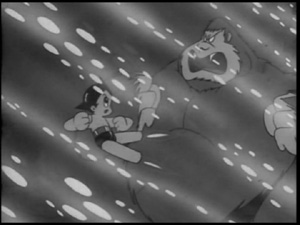
The series opens, naturally, with the birth of Astro Boy (here placed in the year 2000). The narrator describes the surprisingly grim events, a story that would in no way make it past American network executives today if this show was being made for the first time. The tragedy of Astor’s death, the grief of Dr. Boynton that drives him to madness, and the poignancy of Astor’s rejection by his “father” are all on stark display. By the end of the first episode, Astro has been brought back to the Institute by Elefun, just as a new Robot Bill of Rights has been announced. Civil liberties for robots will continue to be a running theme on the show, obviously meant to provide the same social commentary that appeared in the comics.
Astro’s robot parents arrive in the second episode, and his sister in episode 25. Along the way, Astro leads an Expedition To Mars (episode #3), goes on a treasure hunt (#4, The Sphinx), meets a boy from another planet (#6, Grass Boy), fights European dictator Rudolph Hatter (#10, The Spirit Machine), fights giant snails created by Prof. Nutty Fruitcake (#14, One Million Mammoth Snails), gains a human heart (#17, The Haunted Ship), travels in a Time Machine (#18) and fights a giant robot from outer space (#19, The Cosmic Giant). The second half of this initial season sees Astro go to school, and encounter several creatures including a Beast From 20,000 Fathoms— this was once considered a “lost” episode, one which was farmed out to another studio. Rumors persist that Tezuka had possibly destroyed the episode before it could be shown in Japan, but it was still made into an English version.
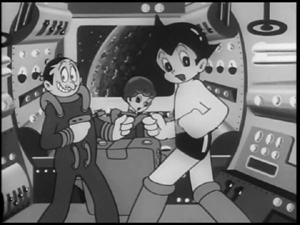
The stories are consistently fun, though they are uneven in execution. The show has a definite charm, a zest for life that was the root of Tezuka’s work over the years. Astro is constantly learning how to be human, and generally tries to find peaceful solutions for conflicts (at least in the English language version); of course, this usually fails and he ends up fighting with another robot! Still, his innocent optimism is refreshing, and the playfulness of the stories makes watching the show a pleasure. There are drawbacks, though. The animation is quite limited, especially the early episodes, sometimes devolving into a montage of still drawings. Even at its best, particularly as the show progresses, the animation is no better than what was to be seen in the U.S. at the same time period, although at least it is expressive. The backgrounds are often very sparse (or nonexistent), and stay quite ordinary. Unlike some other cheaply produced cartoons, Astro Boy favors simple literal drawings for its backgrounds over more interesting graphic pop art styles. The pacing is also wonky, as the stories tend to jump around (this might be partially blamed on the English version’s editing, but the same thing is found on the original Japanese versions shown on Disc 11 of each set). Additionally, the hokey quality of the English names may get to you as well, as they have a tendency to undermine any dramatic tension (I guess that was probably the point).
The same might be said of the bizarre sound effects chosen for the show. The pops, boinks, and whirls are decidedly retro, simultaneously adding to the charm and taking you out of the action. The dubbing also tends to be rushed, as the English voice artists struggle to get through their dialog in the time allotted. (Astro, by the way, was dubbed in English by a woman named Billie Lou Watt, later to handle dubbing chores for Kimba and Gigantor’s Jimmy Sparks.)
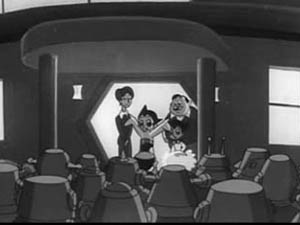
For pure entertainment value, the casual viewer might wish to skip ahead to the 1980s Astro Boy, which at least is in color and has generally better animation and dubbing, not to mention the audio-visual quality of those DVDs. Any true Astro Boy fan, however, will devour these sets with glee. This is the real deal for a past generation of kids, and it is a true pleasure to see it treated so respectfully on DVD. The show may seem primitive by today’s standards, but it was the first of its kind, and that’s worth something.
Right Stuf’s DVD sets each contain 52 episodes on 10 discs, plus another disc for special features, for a grand total of 22 discs of classic Astro Boy. It may take you years to get through it all, but those will be years of enjoyment.
Is This Thing Loaded?
Set One
All extras are found on the final discs, number 11 in each set. On the first set, there are two full Original Japanese Episodes presented with English subtitles. These episodes are Birth of Astro Boy and Toxor, the Mist Man. Then there is an Interview With Fred Ladd – Part 1 (18:42), which is more of a long on-camera monolog where Mr. Ladd discusses the history of Astro Boy in Japan and America. Finally, there are Galleries for character models and vintage Astro Boy merchandise, with each gallery offering only a handful of images.
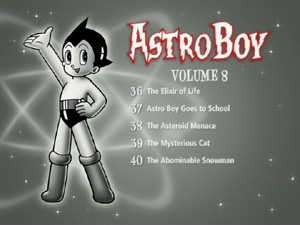
Set Two
The extras in the second set get a little more interesting. While basically a cool novelty in the first set, the Original Japanese Episodes on the second set provide much extra value. Beast From 20,000 Fathoms is shown only with Japanese audio commentary (English subtitled), discussing the unique production history of this once-thought “lost” episode. A text screen helps to introduce the episode’s history, explaining how Mushi outsourced this one episode to a studio called Studio Zero. Then, as the episode plays, the surviving animators (all celebrated manga artists) talk about how the episode came together. This is pretty interesting stuff for the Astro Boy aficionado. Then, another true rarity is shown, with the original Japanese version of The Moon Monsters, an episode which was made, but never broadcast, in color! Once again, a text screen describes what made this episode unique, explaining that it was done as a potential spin-off pilot. I got a real kick out of seeing classic Astro Boy done up in color, presented here with English subtitles. Just as cool is The Greatest Adventure On Earth, which was the final episode of the original Astro Boy ever made— number 193! As NBC had long ago stopped buying new episodes, this one was never dubbed in English or shown at all in the U.S., so it’s fascinating now to see how the series was ended. Look for a cameo by Tezuka, and a surprising end for our hero.
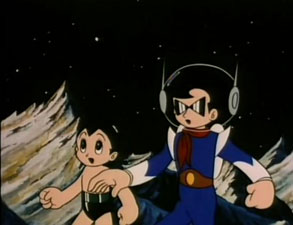
The Japanese episodes alone would have made this disc outstanding, but there’s more! About a half-hour of Deleted Scenes are featured, comparing the original Japanese episodes with the edits made for American broadcast. These are really very interesting! In some cases, the edits were simply done to remove Japanese cultural references or text (e.g. a newspaper headline), but some of the cuts are more curious, such as removing Christian references (one would think that those would have been more out of place in Japan!), and taking out certain scenes of violence, particularly any showing of Astro Boy using his butt guns. (Yes, you read that right. It’s pretty bizarre, apparently too much so for American youngsters in the 1960s.) There is also an additional five minutes of deleted episode introductory scenes.
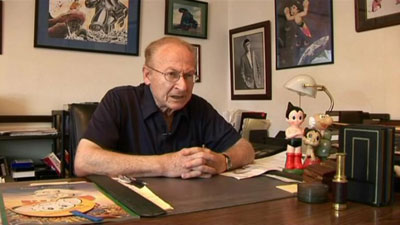
The second part of the Interview With Fred Ladd (13:30) offers more of Ladd’s reminiscing about bringing Astro Boy to America. Here, he discusses naming the characters in the English version, prepping the pilot for NBC, and adding English lyrics to the theme song. He also reveals what made NBC take the unprecedented step of buying a second set of 52 shows.
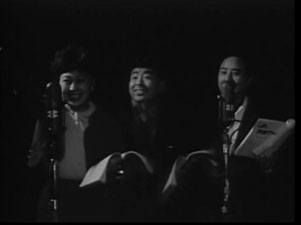
An Original Character Art Gallery has about a dozen style sheets, and the Merchandise Gallery has seven stills. Finally, another gem is included, with the vintage black and white featurette Behind The Scenes At Mushi (7:22). This is a similar studio tour to those we’ve seen on countless past DVDs, except this time it’s the Mushi studio doing Astro Boy, back in the day! Way cool footage, I say. There are even clips of the voice actors (including the girl doing Astro Boy) recording their lines as they watch the completed animation.
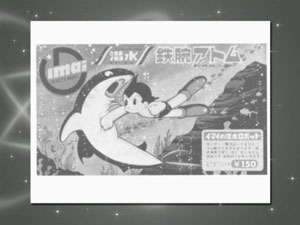
All together, this is a very impressive package of extras for such an old show.
Case Study:
As one would hope, these 11-disc sets have been packaged into very attractive (and heavy!) boxes, with an appropriately nearly monochrome design (except for some spot reds). In each set, the ten episode discs are housed in five 2-disc slimcases, while the bonus disc is in an ultra-slim. There is also a booklet (32-pages in Set One, 24 pages in Set Two) with information on the series and episode synopses. All of this is included in a box that has an outer slipcase. (Note: The Australian version of the sets, released earlier, came in a metal tin.) Interestingly, the DVD cases are clear, and the paper insert is reversible, so that you may choose your own version of the case’s cover. Each side includes beautiful artwork and episode listings. These are gorgeous sets!
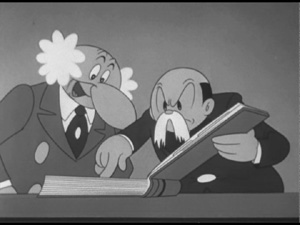
Ink And Paint:
Each disc opens with a notice about the origin of the materials used for this collection. With the original English masters destroyed over thirty years ago, Madman could not be too choosy when it came to a number of the episodes. In many cases, materials were likely very limited, and they did the best they could. As a result, these are not pristine copies. They do not look as good as Rocky And Bullwinkle And Friends or Yogi Bear. I can only guess at what they had to use, but there are dirt specks and scratches galore, not to mention some serious picture blinking in the worst episodes. I don’t wish to give a false impression, though— most of the episodes are quite watchable, and the good news is that the DVD producers left plenty of room for compression, and as a result the shows at least are largely free of compression artifacts. Overall, this is about as good as it can likely get, short of spending millions of dollars on further restoration.
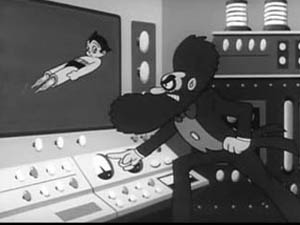
Scratch Tracks:
The notice at the beginning of each disc makes special mention of uneven audio quality. It does vary quite a bit, even between the fairly clear first episode and the tinny, distorted and echoing sound of the second. Again, this is the best that could be done, so there is no point in making any big criticisms here. We can just be thankful that all these episodes could be discovered at all. Do note that these are only the English versions— no Japanese tracks are available except on the bonus discs.
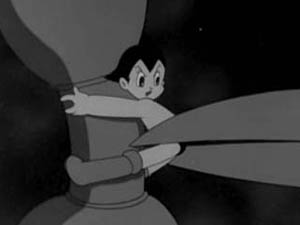
Final Cut:
Maybe this is just the right time for the original Astro Boy to be brought back out for another look. There is a sense now that people are ready to move past the antiheroes that have filled our movie screens and television sets the past two decades. With a desire for more clear-cut morality, and heroes pure of heart, Astro Boy certainly fits the bill. Potential buyers of this set will need to keep in mind the uneven quality of the video and audio, and the simplicity of the animation; but the stories themselves are fun and uplifting, and Astro Boy makes for a wonderfully innocent and likeable hero. This is an ideal series to show to your children (maybe once you get past the origin story, if your child is very sensitive), filled with positive messages about peace and tolerance. And for those who are interested in television or animation history, this set is required viewing.
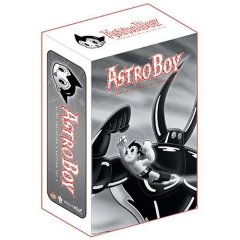 | ||
 |








